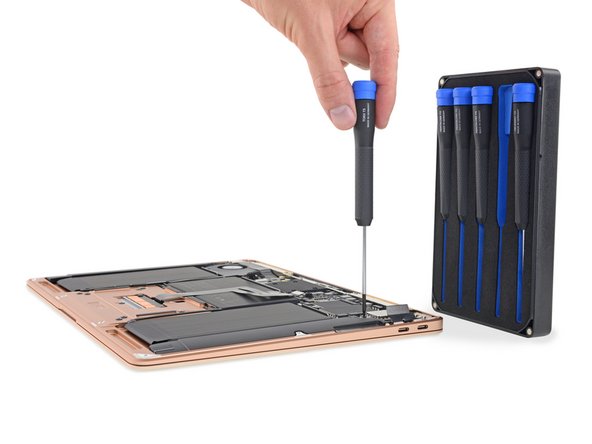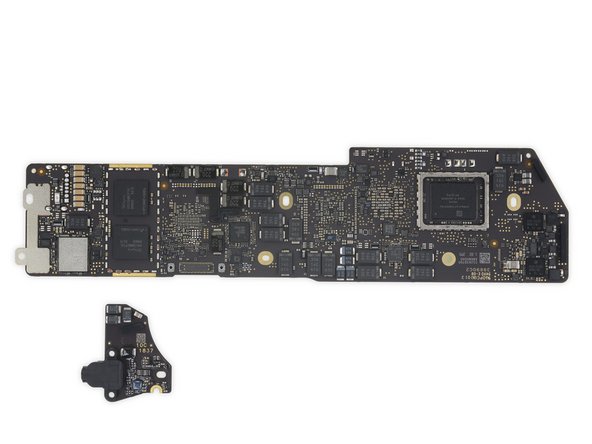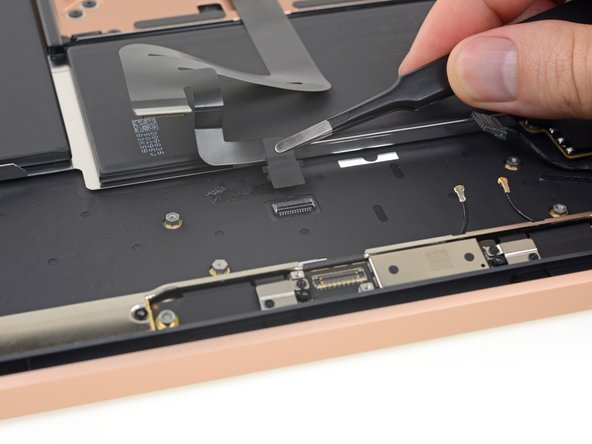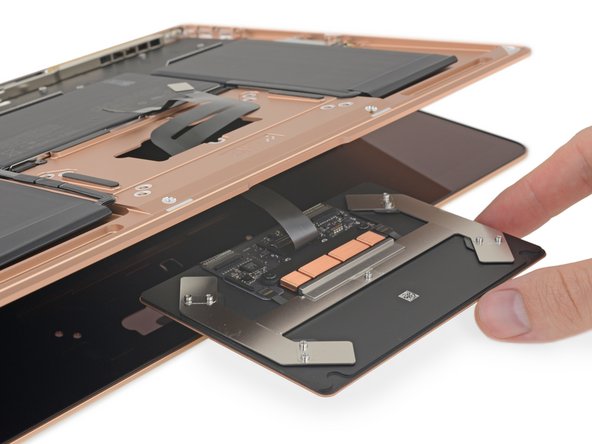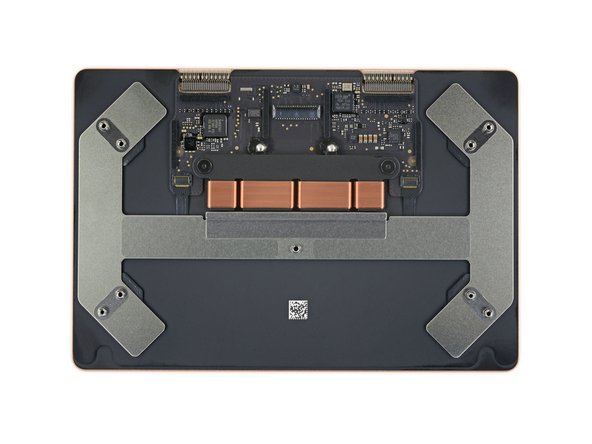Introducción
Luego de años de negligencia, Apple ha finalmente actualizado la muy querida MacBook Air. ¿Tiene este peso ligero nuevo lo que necesita para estar al día con las ultraportátiles del 2018? ¿O son solo
fanfarronerías? Abrámosla y averigüemos.
Síguenos en Facebook, Instagram, y Twitter para mantenerte al tanto de los últimos desmontajes. Suscríbete al boletín de noticias para recibir desmontajes en tu casilla de correo.
Qué necesitas
Resumen del Video
-
-
Vamos a despejar la nueva MacBook Air y algunas de sus especificaciones:
-
Pantalla de retina IPS con LED retroiluminada de 13.3", con una resolución de 2560 x 1600 (227 ppi)
-
Procesador de doble núcleo 1.6 GHz Intel Core i5 (Turbo Boost de hasta 3.6 GHz) con Intel UHD Graphics 617 Integrado.
-
Coprocesador/chip de seguridad a medida Apple T2
-
8 GB de 2133 MHz LPDDR3 SDRAM
-
SSD basado en PCIe de 128 GB
-
802.11ac Wi-Fi y Bluetooth 4.2
-
Dos puertos Thunderbolt 3 (USB-C) que soporta carga, DisplayPort, Thunderbold, y USB 3.1 Gen 2
-
-
-
Antes de aventurarnos adentro, hacemos una inspección general de algunas de las características externas de la nueva Air.
-
En su parte inferior, podemos encontrar algunas letras pequeñas y algunos tornillos pentalobe de colores combinados.
-
Al abrirla, nos saluda un familiar teclado tipo mariposa de última generación e inmediatamente experimentamos de MacBook Pro.
-
La Air se parece muchísimo a la MacBook Pro Sin Barra Táctil de 13": aparte del grosor y el ID Táctil, son casi indistinguibles.
-
...y a pesar de la nomenclatura "Air" (aire, en inglés) esto hace que la MacBook de 12" se vea como un peso ligero en comparación.
-
-
-
Por supuesto, ninguna encuesta externa estaría completa sin un pequeño reconocimiento de rayos X.
-
Con la ayuda de nuestros amigos en Creative Electron, podemos ver lo que está por venir.
-
-
-
Un último desvío antes de dirigirnos adentro: no podemos resistir sacar nuestra tecla de comando favorita para un vistazo a la membrana resistente al ingreso de polvo o agua.
-
Nos guste o no, parece que lamariposa llegó para quedarse.
-
Luego de algunos giros de nuestro destornillador para pentalobes, un buen tirón libera la caja trasera de sus dos clips y estamos en el interior.
-
En el interior, divisamos: una placa lógica pequeña, un ventilador solitario, un par de altavoces grandes y elongados, y un disipador de calor interesante parecido a un radiador.
Louis Rossmann expresses concern that the fan on the redesigned MacBook Air would not be particularly effective at cooling. Looking at the photos in this teardown, I would concur. Can anyone explain how the fan actually cools the computer, and how effective is it? Rossmann posted a video of this on YouTube in response to a dead CPU caused by overheating.
Hi Anthony,
The first string of comments at the bottom of this teardown goes into the cooling setup in more detail.
-
-
-
Solo seis tornillos Torx y unos pocos conectores de cable nos separan de la extracción de la placa lógica. ¡No está tan mal! Ciertamente no es un trabajo que nuestro kit de destornilladores Marlin no pueda hacer.
-
¡Y así salió! La placa lógica de la Air no tiene forma de bigote como la de la Pro ni tampoco tan minúscula como la de la MacBook.
-
Luego, nos dirigimos a la placa hija, que alberga una toma de auriculares (en peligro de extinción) y algunos conectores para el altavoz y sensor de ID Táctil.
-
El audio codec Cirrus Logic CS42L83A también reside en esta placa.
-
-
-
-
La placa puede ser pequeña pero tiene bastante potencia de procesamiento:
-
Procesador Intel SREKQ Core i5-8210Y
-
Coprocesador Apple APL1027 339S00535 T2
-
Almacenamiento flash SanDisk SDSGFBF12 043G (128 GB total)
-
Controlador Intel JHL7540 Thunderbolt 3
-
338S00267-A0 (posiblemente un Apple PMIC)
The Apple T2 Chip is already almost as large as the Intel i5 Chip. Imagine what will happen in a few years when ARM is replacing x86-64 on MacBook.
Who knows? Apple may announce for macOS 10.16 an ARM version of the OS that can run on existing T2 devices.
Haha
where can I buy this board, I want to upgrade my ram and also my storage. Actually I have 8gb of Ram and 128gb of storage
-
-
-
Damos vuelta a la placa para encontrar más chips:
-
2x SKhynix H9CCNNNCPTAL LPDDR3 RAM (8 GB total)
-
Murata 339S00446 1ZE SS8915047 (posiblemente módulo Wi-Fi)
-
Intersil 95828A HRTZ X829PMJ
-
Módulo NFC seguro NXP 80V18
-
Memoria flash serial multi E/S Macronix MX25U3235F
-
Controlador de potencia Texas Instruments CD32-15C00
-
Convertidor buck sincrónico Texas Instruments TPS51980A
I believe that TI’s CD3215C00 is a USB 3.1 redriver.
-
-
-
¡Frente a la toma de auriculares, observamos algunos puertos súper modulares Thunderbolt!
-
Empezamos bien con esta MacBook, por lo que a nosotros respecta, todos los puertos están asentados en sus propias placas y se pueden reemplazar fácilmente.
-
Finalmente, nos encontramos con la parte responsable por soplar aire dentro de esta Air.
How does this fan cool the CPU? They seem separate.
It doesn’t https://youtu.be/iiCBYAP_Sgg
I think the fan creates a slight vacuum/negative space in the chassis, pulling fresh air from vents across the board and expelling it out the back.
I heard you can’t swap out the SSD in the 2018’s?? I wanted to put a 256GB in, can I do it? I was told no.
You heard correctly! The flash storage is integrated into the logic board and and paired to the T2 chip so it cannot be swapped out, unfortunately. You can see it in step 6.
if you will put a fan, at least put in the cpu, not as a chasis fan, that’s stupid.
I want to replace the Ports for my MacBook Pro (13-inch, 2018, Four Thunderbolt 3 Ports). Can you tell me the tools and the parts I need, and how much they will cost?
Bouna
-
-
-
Continuando la tendencia amigable hacia la reparación (o al menos más amigable), encontramos lengüetas adhesivas elásticas debajo de los altavoces elongados.
-
No nos gusta el adhesivo. Los tornillos reutilizables son casi siempre mejor. Pero tirar de estas lengüetas tipo iPhone es muchísimo mejor que solventes pegajosos y palanqueo.
-
Además, la sola presencia de adhesivo elástico de liberación generalmente significa que al menos se pensó en posibles situaciones de reparación y desmontaje.
-
-
-
Seguimos y enforcamos nuestra atención al panel táctil.
-
A diferencia de MacBooks Pro más nuevas, que tienen paneles táctiles reemplazables de primer paso, este panel táctil comparte un cable con el teclado que está sujetados bajo la placa lógica.
-
Al sacar el panel táctil, no podemos dejar de pensar en cierto luchador TIE
Are you certain that the split in that trackpad cable over the center battery wouldn’t allow a bit of “service loop”, just enough to disengage the cable connector from the socket on the trackpad with a spudger without needing to remove the logic board? Seems a rather conspicuous cable design to not provide some benefit. If anything, I’d bet that flexing that cable split does yield some length, yet also leaves permanent (no warranty for you!) evidence it was done.
No guarantees, but it didn’t look like it could be done safely. The end of the cable is also pretty firmly glued to the trackpad near its socket, so getting it off would be tricky, and there’s not really any slack to speak of. The photograph that has been circulating from Apple’s internal service manual for replacing the battery also appears to show the logic board removed.
These are so much shittier to work on than the older macbook airs
-
-
-
Gracias a nuestros amigos de MacRumors, sospechábamos que remover esta batería podría ser menos catastrófico que en algunas Retinas que conocemos.
-
Como era de esperar, encontramos cuatro tornillos y seis tiras adhesivas que sujetan el paquete de potencia.
-
Un marco fuerte, un poco parecido a aquellos de las anteriores Air, soporta la manada de celdas de batería y hace que la extracción sea rápida.
-
Aquí está: la central eléctrica de 49.9 Wh. En caso de que esté realizando un seguimiento, es un poco más pequeña que en la nueva XPS 13 (52 Wh) de Dell, pero más grande que la de la Surface Laptop 2 de Microsoft (45.2 Wh) y la próxima Specter x360 de HP (43.7 Wh).
Are the battery cells terraced / wedge shaped or the same Z-height throughout? I can’t quite make that out from the photos…
The batteries are not terraced and reside in the same plane. All three cells are laid flat on top of the metal tray.
-
-
-
Las cosas se están poniendo más Airosas dentro del chasis dorado: casi podemos ver la línea final.
-
El soporte metálico de la antena y el nuevo sensor de identificación táctil (¡modular!), asegurados cada uno por tornillos Torx todavía permanecen por encima de la caverna de la batería.
-
Para que sepas, el sensor de ID Táctil puede salir directamente luego de que la placa de audio más pequeña haya sido removida. Nosotros solo elegimos dejarla.
-
¡Un par de tornillos Torx más tarde, la pantalla está libre! El panel nuevo de Retina es casi igual al que encontramos en la línea MacBook Pro, con la diferencia en el brillo máximos (300 nts vs. los 500 de la Pro) y la compatibilidad con la gama de colores P3.
How do you get the heat sync bar off?
I have run into an issue, I’m replacing the display and managed to get one screw from the three metal plates covering the connectors, they look to be all the same size, but I can’t get the others. Those are all I need to remove and then I can pop the new one on…..any idea which torx screwdriver is used here? I thought it was T3.
-
-
-
Vamos a dejar esta MacBook Air fuera un poco para que puedas admirar sus partículas.
-
Con puertos modulares y adhesivo con tiras extraíbles, la nueva MacBook Air se destaca contra una tendencia a la disminución de la reparabilidad en las computadoras portátiles de Apple.
-
Desafortunadamente, todavía tendrás que lidiar con los pentalobes y el almacenamiento y RAM no se pueden actualizar. Si bien esta actualización parece favorecer más a los técnicos experimentados que a los reparadores principiantes, tenemos la esperanza de que es el primer paso hacia MacBook más reparables.
-
- Muchos componentes son modulares y con acceso directo, incluyendo los puertos, ventilador y altavoces.
- Además de los tornillos molestos pentalobe, esta laptop se abre tan fácilmente como otras.
- La batería está sujetada con una combinación de tornillos y adhesivo con liberación elástica, pero tendrás que remover la placa lógica y los altavoces para accederla.
- El teclado está integrado en la caja superior, lo que requiere un desmontaje total para reparación.
- El almacenamiento y RAM soldados y sin poder ser actualizados o reparados es una decepción seria en una laptop de más de US$1.200.
Consideraciones Finales
Calificación de Reparabilidad


(10 es lo más fácil de reparar)
Un agradecimiento especial a estos traductores:
50%
Estos traductores nos están ayudando a reparar el mundo! ¿Quieres contribuir?
Empezar a traducir ›
61 comentarios
Am I losing my eyesight, or is that fan not directly connected to any type of heat dissipating hardware? Looks like it’s either just providing a general low-pressure-air-flow throughout the internals - OR - it pushes air back through that antenna/heatsink-bracket-type-thing and coming out the other end of it?
Could you confirm or explain this in more detail?
I think it is just an exhaust fan, that removes hot air from a laptop case outside (from the right side of the case, under the screen) and creates a negative pressure inside, which helps a laptop to “suck“ some cool air from the outside through the intake on the left side of case, under the screen. The shape of the radiator ribs also suggests some airflow from left/right side of the case to the opposite side.
Serge B. -
The only thing that fan is doing is moving a (tiny) bit of air indirectly across the logic board and the heatsink. Or at least that is what I think it does. As there is no direct heat conduction from logic board to case, the fan isn’t there to cool the case, that’s for sure.
Yeah it is just a case ventilation fan, it doesn’t blow any heatsinks directly. Although with the very low TDP of the processor, a case fan with radiator type heat sink should do the job.
Tom Chai -
Yes, as the 12” Macbook with a ~5W TDP chip manages without a fan, I’m sure a slower general airflow together with that heatsink works well for the 7W chip in the 2018 MBA.
And when looking closer - the vents on either side of the antenna bracket, that the fan exhausts through on one side - air is drawn in on the other side and then guided by the vanes in the ventilation holes, allowing it to flow easily from right to left (when viewing bottom/inside of the MBA) over the heatsink cooling fins. There doesn’t appear to be any other openings in the chassi, so Apple has probably designed the airflow pretty efficiently in this fashion.
Pretty cool! Only Mac laptop I’ve seen with a fan but without heat-pipes/sinks by the fan.
This thermal design reminds me of the old Titanium Powerbooks, especially the heatsink. That had two fans I believe, one pulling in from the side and one blowing out the back. I think this pulls air from one side of the monitor hinge vents and exhausts out the other.
Why don’t they use the aluminum body directly as a huge heatsink?
You’ll notice that they’ve sealed the mid-area under the display bezel, with only an opening on the side furthest from the fan, nothing above the CPU, and an outlet the fan blows air out of.
I’m guessing they did this to cool both the low power, yet still warm T2, as well as draw air over the CPU.
It’s not blowing directly on a heatsink connected via heatpipe to the CPU, no, but I’m guessing they weighed up the pro’s and con’s of heatpipes, and decided that sucking air through a tightly controlled path is preferable to the bulk added by heatpipes.
It’s no different than the trashcan mac pro, is it? That just sucks air up over the heatsinks if I remember correctly.
What matters is that airflow is limited to a strict path, that’s in the left side of the laptop, over the T2 and SSD’s heatspreader, over the CPU’s radiator, through the fan, and out the right side.
It’s really bad to know that neither storage nor RAM is upgradable. If I go for 128 GB SSD and 8 GB RAM then I can never upgrade them, disappointed :(
That is the main reason why you should avoid those Apple new laptops. The other one is that each of the Apple laptops has design flaws (and this has happened for many years) : check Louis Rossmann videos on youtube, this is eye opening.
Oli Wek -
When will the new iPad pro teardown be revealed plz. Deadly waiting for it
They’re still heating up the glue.
Interesting, confirms what I thought in their render that showed the insides, that the fan was too close to the back for their usual spacing for a heatsink there. Looks like the fan just ambiently cools the chassis and moves internal air, rather than directly passes over a heatsink.
These MacBook logic boards are gonna end up in iPhones soon if they continue shrinking
lol that was a nice one :)
“These MacBook logic boards are gonna end up in iPhones soon if they continue shrinking”
I think you have that backwards.
I’m still confused about how the display data cables interact with the hinge. In the 2016 MBP teardown, I thought iFixit said they get rolled up or something. While the pictures in this teardown helped shed some light on this mechanism, I’d really like to see some detailed shots of how exactly that all works. Maybe in classic iFixit style where the position of just a few things within the frame changes seemingly magically between two pics. Thoughts/comments?
Hey iEvan! This is a teardown, which is an entertaining (and abbreviated) peek inside the device, not a step-by-step disassembly guide, hence the “magical” changes. If you want to see how MacBook Air display cables and hinges interact, check out our MacBook Air display replacement guide, in concept the process hasn’t changed.
If I am reading this correctly, there is absolutely nothing about Battery being better positioned to be easily replaceable. Merely that Apple guidelines now allow Battery to be replaced without changing the top case.
That is Apple stopping all those who had Apple Care to get a new top case with their battery replacement or people getting ( used to ) getting around their Keyboard problem with battery replacement.
Thanks for a great review. I’m really enjoyed your works. Thumbs up..
I think this review just swayed me from Surface Laptop 2 to the new Air. I can live with two cores vs having to throw away the laptop at the first hurdle. Plus the resale value of all surface devices is, well, pretty much non-exitent. And for a good reason.
Where is the hardware microphone disconnect?
Why there is a NFC chip on board? Does MacBook Air even support NFC?
Or it’s some kind of secure enclave?
Secure Enclave would be on the Apple T2; good question about that NFC if that’s its sole function
VaughnSC -
NFC chips tend to pop up on devices without NFC from time to time, the Droid Razr had one, I’ve seen them from time to time on other phones, and now this.
I’m half guessing they’re added on in production, and nearing the end NFC gets cut from the hardware for whatever reason and it gets left there.
I’m sure some schematics, or in time, Louis rossmann will work it out (when it dying ends up killing boards)
I’d say secure enclave, but that’s the T2’s job. Maybe the T2 (coughA10cough) depended on the NFC chip it expected on iPhones, so they through it on just to keep the thing happy? I wonder if the iMac Pro has one…
Still, I’d expect NFC to be a more Macbook thing, maybe a reader under the trackpad for pairing that got scrapped?
What about the hinges? Did you guys take a good look at them? Are they the same as the MBP, or did Apple use a different design? Wondering what their durability is going to be over the long term.
can this retina display be installed on old macbook air models? like early 2015 model
comes with mojave oder high sierra? Dragon Dictate discontinued :-(
It comes with MacOS Mojave installed.
So is there absolutely no way to replace the SSD in this machine?
There is no way to replace the flash storage in any current Mac (MacBook Pro, mini, iMac, iMac Pro, and the Air) with a T2 chip acting as the storage controller/encryptor.
jbgurman -
Thank you for doing this guys.
Thank you very much for doing this. I had been turning away business on this MBA 2018.
Could I add external micro SSD to USB c I mean is there any space inside the laptop to put external SSD and connect it to USB c by mini USB hub? Will be a maybe good idea to add more storage
Aren’t there three identical SanDisk chips on the logic board? The two labeled ones on one side, and one unlabeled one on the other… doesn’t this mean that this MBA contains 192 GB of NAND?
@getalmeardolis The “043G” on the package indicates a 43 GB chip. Three chips x 43 GB = 129 GB. (There’s probably some rounding to account for the extra GB.) But yeah, three identical chips!
Does it uses the same flex cables that were used in MacBook Pro 2016 onwards?
and is there a chance that MacBook Air(2018) will suffer the notorious flex gate problem?
The display cable arrangement is a bit different from the MacBook Pro, but it uses similar thin (and non-replaceable) ribbon cables. If I had to guess, I’d say it will develop similar problems over time—but that is emphatically just a guess and it’s too early to say anything for sure.
I have currently my new MacBook air 13” retina being repaired by the Apple store Parly II (France), they have to replace the logic board and the touch id. The problem was that it didn’t restart after one night in power safe mode (no display but still heating). After replacing the logic board they called me to inform that the touch id they ordered to replace is not recognized by the logic board, so they have to order once again a new one.
I noticed that it frequently (weekly) had display bugs (white screen with vertical lines and square pixels when moving mouse cursor) while waking up from safe mode, and sometime for no reason while browsing the web in safari.
The technical guy from Genius bar told me that it’s the first time they have to repair a MacBook Air retina 2018, so I’m very unlucky … I guess
components prices :
(661-09714) Logic Board i5, 1.6GHz, 16GB, 256GB : 342€
(661-11677) Touch ID board : 18€
(S1490LL/A) Hardware repair Labor : 79€
Total : 439€ (under guarantee)
(probably not including VAT)
I went to the Apple store Parly 2 to get my MacBook back (repaired) but I refused it at the genius bar because during repair they have damaged the alloy top case, there are now 2 dents (near the touch id and another one near Esc key) that have probably caused by a screwing too hard, the dents are vertically localized just above 2 of the screws which maintain the amovible lower case.
They ordered a new “Top Case with Keyboard, Space Grey, FRA” (price 225€ under warranty + 79€ repair labor).
So now I will have a MacBook Air 13 with almost all part replaced (except battery and screen) !!!
I asked them to replace the whole MacBook but they refused because their policy doesn’t allow it for Mac products (laptops/desktops).
In my opinion, the recycled alloy used in the MacBook air 13 retina manufacturing is not as much resistant as the previous models.
The repair process didn’t take into account the tenderness of this alloy, a dynamometric screwdrivers but they should be used for this models to prevent damages.
Apple CEO’S: Let’s build and design a fanless laptop!
Apple Manafacturers: Okay!
*Slips fan into main design*
Wish the guide was a bit more detailed with the nuances of removing the ZIF connectors, etc with the flip up tabs. Didn’t realize until it was too late and may have damaged something.
Hi Brian,
I’m sorry to hear that! As stated in the warning op top, this teardown is an educational first look at the device, and is not meant to be used as a guide. Our repair guides will show up here, and contain accurate details (such as tools needed, how to unlock ZIF connectors, etc.) as well as step by step instructions on how to complete the repair.
Hi,
I spilled hot chocolate on my macbook air and I want to change the keyboard and the trackpad. There is no way to only change the keyboard without demantling everything?
That is correct. The keyboard is part of the top case and is not easily replaceable. The trackpad, on the other hand, can be removed pretty easily.
Hi, thanks for all the tips in this breakdown. Question for you, I have a sticky down arrow key on my keyboard, can I somehow pop it off and clean underneath it ?? I see in step for you use a tool to pop off the apple key, so wondering/hoping this can be done on the down arrow key !
While cleaning my then-new MBA Model A1932, some specks of something came between the screen and the machine, making tiny punctures that killed the screen. I now am able to buy a screen replacement assembly for about $300 (it was over $500 before). I understand this isn’t the easiest machine to take apart, but if it’s only replacing the screen assembly, is it manageable? My dealer wanted $1000 for a total replacement, which is about the same price as buying a new one. Am I pulling a job I can do, as a seasoned Macbook Pro upgrader, or is this just too exotic?
Hi Bob,
It depends on the screen you’re buying. If it is a complete top assembly, I think it is pretty doable. Take a look at our guide and see how comfortable you would be with the procedure.
What about MBP having pull tabs?
Ciao Fedo! Purtroppo è integrata alla scheda madre quindi non è possibile sostituirla. Bisogna cambiare l'intera scheda madre.











